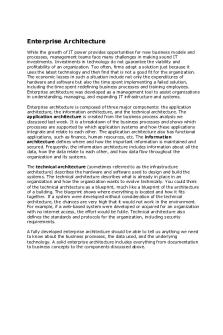RQin System Architecture PDF

| Title | RQin System Architecture |
|---|---|
| Course | System Administration |
| Institution | University of Batangas |
| Pages | 3 |
| File Size | 66.8 KB |
| File Type | |
| Total Downloads | 10 |
| Total Views | 141 |
Summary
Review questions answers....
Description
Mariel Hernandez 1701640 | IT3-1 Review Questions in System Architecture
In 2-3 sentences answer the following questions. 1. What is necessary for the ERP implementation to be successful? Enterprise system architecture takes the functions of an organization into consideration to define the necessary ERP modules, as well as the physical components such as hardware, software, and networks necessary to operate the ERP system.
2. What is ERP system architecture? It’s a methodology of separating the components of an ERP system into tiers or layers that make it easier to manage and provide scalability/flexibility.
3. Why is it important to have good enterprise system architecture? Because it explains the relationships between complex information systems components such as hardware and software, with complex organizational components such as business functions, processes, and people. Without both, there is not a complete understanding of the system and therefore, it will fail.
4. What is the role of architecture in ERP implementation? To provide support for the various business functions such as accounting, human resources, inventory, etc.
5. List five of the major functional modules of ERP. Self-services, performance management, financials, procurement and logistics execution, and product development and manufacturing.
6. Discuss the different types of ERP architectures. Two-tier: server handles application and database duties. Clients are responsible for presenting the data and passing input back to the server. Three-tier: application, database, and presentation are separated into layers that communicate with each other. N-tier: any number of tiers defined in an architecture. Web Services: splitting the presentation tier in two additional layers, Web Services and Web Brower. SOA (Service Oriented Architecture): object-oriented architecture that can extend beyond the corporate firewall onto the web.
7. List benefits and limitations of one ERP architecture. Two Tier Benefits
Three Tier Limitations
Benefits
Easy to use
Inflexible for growth
Can scale well
Low Infrastructure cost
Requires expensive middleware
More reliable
High performing small workgroups
Changes in database affect application Proprietary restrictions Limited flexibility
Flexible to changes
Limitations Higher infrastructure cost Complex
Lower support and maintenance cost Able to reuse components More secure
8. What is service-oriented architecture and how is it different from Web services architecture? SOA is object-oriented architecture that can extend beyond the corporate firewall onto the web and is more of a software development methodology that is independent of technology than an application, such as Web Services that use specific technologies, such as SOAP or XML.
9. What are the key benefits and limitations of systems integration? Benefits: better data sharing, improved decision making, cost efficiency, less duplication, and necessary for e-commerce, SCM and CRM Limitations: requires initial setup costs, data sharing can create political problems within department and divisions, more security and privacy risks, etc.
10. What is the role of management in designing enterprise systems integration? Management plays a crucial role in e-integration. People involvement and change management are crucial for enterprise integration and without management support this task can become very difficult....
Similar Free PDFs

RQin System Architecture
- 3 Pages

computer system architecture
- 7 Pages

Database system architecture
- 8 Pages

System architecture - assignment
- 5 Pages

Chapter 10 System Architecture MCQ
- 24 Pages

FILIPINO ARCHITECTURE
- 22 Pages

CISC Architecture
- 4 Pages

Enterprise Architecture
- 1 Pages

object architecture
- 6 Pages

Révision Architecture
- 4 Pages

Software Architecture
- 120 Pages
Popular Institutions
- Tinajero National High School - Annex
- Politeknik Caltex Riau
- Yokohama City University
- SGT University
- University of Al-Qadisiyah
- Divine Word College of Vigan
- Techniek College Rotterdam
- Universidade de Santiago
- Universiti Teknologi MARA Cawangan Johor Kampus Pasir Gudang
- Poltekkes Kemenkes Yogyakarta
- Baguio City National High School
- Colegio san marcos
- preparatoria uno
- Centro de Bachillerato Tecnológico Industrial y de Servicios No. 107
- Dalian Maritime University
- Quang Trung Secondary School
- Colegio Tecnológico en Informática
- Corporación Regional de Educación Superior
- Grupo CEDVA
- Dar Al Uloom University
- Centro de Estudios Preuniversitarios de la Universidad Nacional de Ingeniería
- 上智大学
- Aakash International School, Nuna Majara
- San Felipe Neri Catholic School
- Kang Chiao International School - New Taipei City
- Misamis Occidental National High School
- Institución Educativa Escuela Normal Juan Ladrilleros
- Kolehiyo ng Pantukan
- Batanes State College
- Instituto Continental
- Sekolah Menengah Kejuruan Kesehatan Kaltara (Tarakan)
- Colegio de La Inmaculada Concepcion - Cebu




